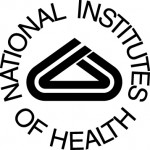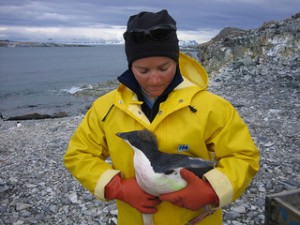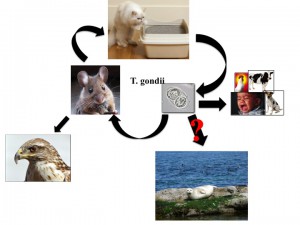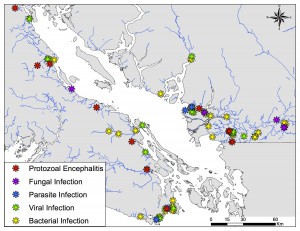Tel: 604.822.8181
Fax: 604.822.8180
E-mail: k.haman@oceans.ubc.ca
Research Interests: Disease ecology / epidemiology of infectious pathogens in the marine environment
Research Area: The Salish Sea
Research Topic: Land-to-sea transfer of infectious diseases affecting wildlife health in and around the Salish Sea
Problem: Infectious diseases are intimately connected with ecosystem dynamics that support biodiversity and as such pose both direct and indirect threats to species conservation. Extremely pathogenic parasites of known terrestrial origin, such as Toxoplasma gondii, Sarcosystis spp., and Neospora spp, are becoming prevalent in marine mammals in the Salish Sea. Alarmingly, co-infection with two or more of these parasites results in increased morbidity and mortality of infected harbor seals. The overall impact of these infectious pathogens on marine mammal and ecosystem health in the Salish Sea remains unknown.
Schematic of life cycle for T. gondii: Cats serve as the definitive host and pass viable oocysts, which then infect the intermediate host. Recent research has documented T. gondii and other coccidian parasites as causative agents of disease in Pinnipeds and Ceteceans in the Salish Sea. These other coccidians, such as Neospora caninum, have similar two-host life cycles with an obligate terrestrial definitive host – how these highly pathogenic terrestrial coccidians are entering the marine environment of the Pacific Northwest remains unknown.
Research direction: Making informed assessments for disease mitigation requires understanding 1) how and why infectious pathogens enter and become endemic in the marine environment from terrestrial sources around the Salish Sea, 2) how this has changed over the years, and 3) if there are specific, identifiable patterns and geographic clusters of pathogen emergence in the Salish Sea. Knowledge of the location, cause, and risk factors associated with disease in marine wildlife of the Salish Sea will guide specific conservation systems to prevent pathogen-related mortality in these populations.
Approach: The need to understand how, and why, pathogens enter and become endemic in the marine environment is great. To address this need, our lab will combine molecular genotyping and serologic identification with spatiotemporal geographic analyses of highly pathogenic coccidian parasites of terrestrial origin in marine mammals of the Salish Sea. We will examine the possibility that genotypes from marine mammals represent a specific subset of pathogenic coccidian strains that have become adapted to the marine environment. Geospatial profiling and spatiotemporal analyses will define the environmental conditions that drive pathogen emergence in specific locations, thereby defining pathogen hot zones, or areas of increased exposure to infectious diseases, in the Salish Sea.
Preliminary research:
This map shows cause of death related to infectious disease in terrestrial wildlife along the Canadian portion of the Salish Sea. Note the proximity of the mortalities to major rivers and the prevalence of protozoal encephalitis (infection with coccidian parasites).
|
Publications: Haman K, Norton T, Ronconi R, Nemeth N, Thomas A, Courchesne S, Segars A, Keel K. 2013. Great shearwater (Puffinus gravis) mortality events along the eastern coast of the United States. Journal of Wildlife Diseases. 49(2): 235-245. Haman K., Norton T., Thomas A., Dove A., Tseng, F. 2012. Baseline health parameters and species comparisons between free-ranging Atlantic Sharpnose (Rhizoprionodon terraenovae), Bonnethead (Sphyrna tiburo), and Spiny Dogfish (Squalus acanthias) sharks in Georgia, Florida, and Washington States, USA. Journal of Wildlife Diseases. 48: 295-306. Ren P, Haman K, Last L, Rajkumar S, Keel MK, Chaturvedi V. 2012. Clonal spread of Geomyces destructans in bats with white nose syndrome, Midwestern and Southern USA. Emerging Infectious Disease. 18:883-885 Haman K, Thomas A, Dove A, Harms C, Norton T. 2012. Vitamin and nutrient trace mineral levels in captive sharks compared with free-ranging sharks. In progress. Journal of Zoo and Wildlife Medicine. Haman K, Thomas A, Andrews K, Norton T. Human Impacts on Nesting Loggerhead Sea Turtles (Caretta caretta): Can we Sustainably Develop a Barrier Island? 2012. In progress. Endangered Species Research.
Selected Presentations: Haman, K., Norton, T., Thomas, A., Ronconi, R., Keel, M., Vernet, M., Cape, M. 2012. Great Shearwater mortality events along the eastern coast of the US: do oceanographic parameters play a role? Joint conference of The Wildlife Society and American Association of Wildlife Veterinarinas. Haman, K. Haulena, M. Raverty, S. 2012. A case series of juvenile Beluga (D. leucas) mortalities at the Vancouver Aquarium. International Association for Aquatic Animal Medicine. Haman, K. Norton, T. Thomas, A, Tseng, F. 2010. Health Assessments of free-ranging Atlantic Sharpnose Sharks (R. terraenovae) and Bonnethead (S. tibura) off the coasts of FL, GA, and WA. International Association of Aquatic Animal Medicine. Haman, K. Norton, T. Thomas, A, Tseng, F. 2009. Health Assessments of free-ranging sharks. American Association of Zoological Veterinarians.
I am appreciative of the help and support provided by: |
||||
| INSTITUTE FOR THE OCEANS AND FISHERIES |  |
|||



